From the Big Bang to the Nobel Prize and on to the James Webb Space Telescope
John C. Mather
Observational Cosmology Laboratory
NASA Goddard Space Flight Center
The Big Bang 13.7 billion years ago started the expansion of our piece of the universe, and portions of it stopped expanding and made stars, galaxies, planets, and people. I summarize the history of the universe and explain how humans have learned about its size, expansion, and constituents. The COBE (Cosmic Background Explorer) mission measured the remnant heat radiation from the Big Bang, showed that its color (spectrum) matches the predictions perfectly, and discovered hot and cold spots in the radiation that reveal the primordial density variations that enabled us to exist. My current project, the James Webb Space Telescope (JWST), is the planned successor to the Hubble Space Telescope (HST) and will extend its scientific discoveries to ever greater distances and ever closer to the Big Bang itself. Its infrared capabilities enable it to see inside dust clouds to study the formation of stars and planets, and it may reveal the atmospheric properties of planets around other stars. Planned for launch in 2013, it is an international project led by NASA along with the European and Canadian space agencies.
INTRODUCTION
From the beginning of time to the end of time, with a few details in between, is the story of cosmology. The journey to the Nobel Prize began long ago and far away, on a small planet around an ordinary star in an ordinary galaxy. And now, humans have the temerity to push beyond, to seek to understand the origins of everything—from the primordial explosion, to the formation of objects (stars?) from the initial material, to the formation of galaxies, stars with planets, and even life. Such is the quest of modern astrophysics, and remarkable steps have been taken while enormous mysteries abound.
My personal career began with childhood on a scientific research station, the Dairy Research Station of Rutgers University, located perhaps 75 miles northwest of New York City as the crow flies but immensely distant for a child. My dad was a professor investigating the breeding and feeding of dairy cattle, a subject at one time of immense commercial importance to the state of New Jersey. The chemistry laboratory was located next to the barn where 20 bulls lived, and there were tanks
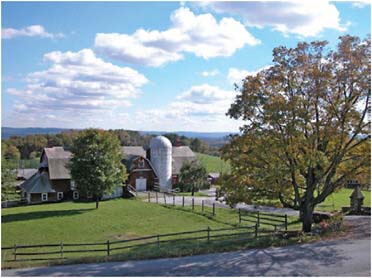
FIGURE 1.1 Lusscroft Farm, Sussex County, New Jersey, where I lived. SOURCE: Courtesy of the Heritage and Agriculture Association, Wantage Township, N.J.
of liquid nitrogen as well as Geiger counters for civil defense against the possibility of nuclear attack from the Soviet Union.
But somehow, the cows were not as fascinating to me as the mysteries of the sky. When I was around 8, my parents took me and my sister to the American Museum of Natural History in New York City, and we saw the planetarium show and the dinosaur and fish bones. My parents also read aloud to me and my sister from biographies of Darwin and Galileo. Quite an introduction to science, which looked very important and a bit dangerous!
Jumping ahead many decades, astronomers now have a coherent story to tell about the origin of today’s universe. We say there was a Big Bang 13.7 billion years ago that started everything, we have a lot of mathematics to describe how it worked, and we have elaborate computer simulations of how the primordial material would grow into the things we see today. But until recently, when the COBE satellite flew, we did not know the details of the starting point, so we did not know what computer simulations to run. The scientific impact of the COBE was to provide that starting point.
Surprise! Explosions in the Bathroom Mirror
One of the great challenges of modern science has been to work out the origins of the chemical elements. When you look in the mirror in the morning, thinking of hair and whiskers and the day ahead, you are looking at the remains of exploded stars. The Big Bang gave us only hydrogen and helium and tiny traces of lithium, and everything else has been made since then by nuclear reactions inside stars. The basic idea was explained by Fred Hoyle in 1946, and developed in great detail over the years. However, much is still unknown about this, since the details seem related to the nuclear reactions that take place during the final explosions of supernovas. Those are very difficult to calculate because the three-dimensional structure of the explosion is highly turbulent.
Looking Back in Time
Astronomers look back in time in a way that is not open to anybody else. We see things as they were when they emitted light, and that can be a long time ago if we are looking at things very far away. The speed of light, immense though it is from a human perspective, is still finite. We see the nearest star as it was 4 years ago, the center of our galaxy as it was 25,000 years ago, and if we look almost to the edge of the visible universe, we look back almost 13.7 billion years. Geologists look at old rocks, historians look at old documents, but astronomers really travel back in time with their telescopes.
Measuring Distances
Astronomers naturally need to know how far away things are, and we have two basic methods (see Figure 1.3). First, we draw triangles, just as the ancient Egyptians did. Given one side and two angles of a triangle, we can compute the other parts. The ancient Greeks, at least some of them, knew how to apply this to get the size of Earth and a rough distance to the Moon, but everything else was too far away for them to calculate. The other basic method astronomers use is the standard candle method: if two objects are known to have the same intrinsic brightness, then the fainter one is farther away, in accordance with the inverse square law. (In the expanding universe, this law has to be modified a bit.)
Measuring Velocities
Of course, we also need to know how fast things are moving. The Sun, the Moon, and the planets move
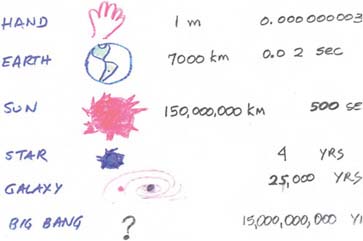
FIGURE 1.2 Looking back in time by looking at things far away.
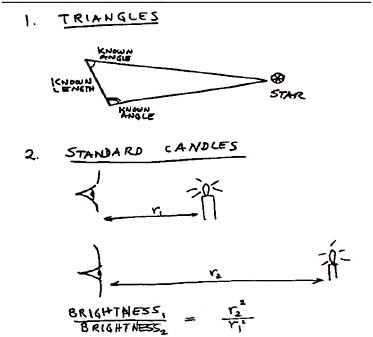
FIGURE 1.3 Measuring distances with triangles, and with standard candles.
pretty fast across the sky, and we know how far away they are, so we can get their velocities very accurately. Some stars also move quickly enough to measure. But most do not move fast across the sky, but we can still spread their light out with a spectrometer. As it happens, stars like the Sun emit a wide range of wavelengths of light, but at certain wavelengths the light is a lot brighter or fainter than one might expect. These special wavelengths are the result of the interactions of chemical elements and molecules, which absorb or emit in very characteristic patterns. That means that we can determine the chemistry and physical properties of distant stars by analyzing their spectra. It also means that we can use the Doppler effect to measure their velocities. If a star is coming toward us, the light we receive is at shorter wavelengths than if the star is not moving, and conversely, if it’s going away, the light is at longer wavelengths, i.e., it is redder. Since the chemical elements have very characteristic patterns, we can determine the apparent velocity (towards or away from us) very precisely.
The Big Surprise: The Expanding Universe!
Back in 1929, Edwin Hubble was using the biggest telescope in the world, the 100-inch Hooker telescope on Mount Wilson, to study distant galaxies. He had recently discovered that there are pulsating stars in the galaxy M31, the great nebula in Andromeda. Since he knew about pulsating stars close to home, and he saw similar patterns in these distant stars, he could estimate the distance to the Andromeda Nebula, and then with much more work, even more distant nebulae. The distances were immense, far greater than those within the Milky Way galaxy. And even more surprising, the distant galaxies were almost all going away from us at high speeds. Remarkably, there was a pattern to all this: the galaxies fit close to a straight line on the velocity-distance plot (see Figure 1.4). So it appeared that all of them were together a few billion years ago! Hubble had discovered the expanding universe in the same year that the worldwide economy collapsed. Needless to say, Hubble’s discovery was front-page news around the world.
Why the Surprise, Dr. Einstein?
Back in 1905, Albert Einstein shocked the physics world, and then the world at large, by proposing that space and time are inevitably mixed together, and neither one has absolute meaning. He was driven to this by “thought experiments” about synchronizing clocks using light signals, then a hot topic in the engineering world. Working in the Swiss Patent Office, he saw many patent applications about this, so it turned out to be a good thing for him that he was not a professor. As it happens, this Special Theory of Relativity also explains why the Michelson Morley experiment could not detect the “luminiferous ether” that was supposed to be the medium in which light waves would oscillate. The famous E = mc2 came from this work. Then, in 1915 and 1916, he developed the General Theory of Relativity, shocking the world further with the assertion that gravitation works by curving space and time. It did not take long for his predictions to be confirmed by Eddington’s observation of the bending of light by the Sun, during a solar eclipse. Einstein applied his equations to the universe as a whole, and (assuming that the universe must be static) added a constant of integration to the equations to keep the (theoretical) universe from expanding or contracting. Why did Einstein assume that the universe had to be static? It was a fair guess, there was no evidence against it, and it seemed simple.
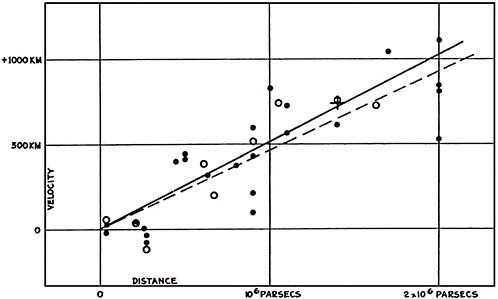
FIGURE 1.4 Edwin Hubble’s plot of speed of galaxies versus distance. SOURCE: Hubble Box 24(1), “Velocity-Distance Relation among Extra-Galactic Nebulae,” Papers of Edwin Powell Hubble, 1900–1989, The Huntington Library, San Marino, California.
But it was wrong. In 1922, Alexander Friedmann, a young mathematician in the Soviet Union, applied Einstein’s equations without assuming the universe would be static, and showed that the mathematics allowed for an expansion. Einstein heard about it and said that was wrong. Three years later, Friedmann died. But in 1927, Georges Lemaître, a Belgian priest and mathematician, came to similar conclusions and was similarly rejected by Einstein, who admitted that the math was OK, but that the physics was terrible. Lemaître named his initial
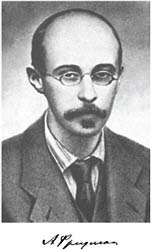
FIGURE 1.5 Alexander Friedmann, first to recognize in 1922 that Einstein’s General Relativity suggests that there was an initial compressed state of the universe. SOURCE: Courtesy of the Russian Federation.
state the Primeval Atom and described in clear terms that the universe was expanding from this extraordinary event. It was only 2 more years before Hubble found by measurement that Friedmann and Lemaître were right, and Einstein had to apologize for what he termed his greatest blunder.
No Center, No Edge!
Curiously enough, the pattern of motion that Hubble found says that there is no center and no edge of the observable universe. We can calculate what an astronomer in another galaxy would observe, and he or she would also see distant galaxies receding, with the same shape of diagram found by Hubble. So, we all think we’re in the middle. Therefore, there can not be a middle. As it happens, this also simplifies the mathematics of general relativity immensely, so it’s very convenient to think that this means the universe is really infinite and almost uniform throughout. But in truth, we’ve only measured a little piece, the part we can see in the 13.7 billion years that light has been traveling. Quite possibly, the part we can not see is pretty different.
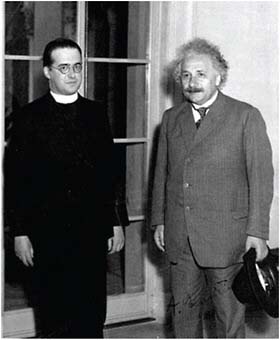
FIGURE 1.6 Georges Lemaître (left) and Albert Einstein (right). In 1927 Lemaître rediscovered Friedmann’s equations and named the Primeval Atom. SOURCE: New York Times Magazine, February 19, 1933.
The Power of Thought
Jumping ahead to the end of World War II, scientists came back to science and started applying the knowledge gained in battle. George Gamow (originally from Kiev) came to Washington and started thinking about the Big Bang (it was not called that yet). He had a young postdoc, Robert Herman, and a young graduate student, Ralph Alpher, and set them to work. This
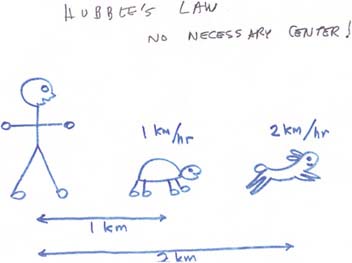
FIGURE 1.7 Three astronomers independently obtain the same Hubble constant from different locations. None can claim to be at the center, so there is no center.
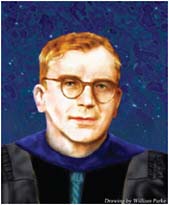
FIGURE 1.8 George Gamow, extraordinarily creative physicist, initiated work on Big Bang physics in 1948. SOURCE: Courtesy of Professor William C. Parke, The George Washington University.
team considered first whether the Big Bang could have made the chemical elements in the abundances that we find them today. The answer was tantalizing: neutrons captured by atomic nuclei would make bigger nuclei, with an abundance pattern like what we see. But, there is a bottleneck: there is no way to make a carbon nucleus by attaching neutrons to smaller nuclei, so the Big Bang can not make all the chemical elements. But the other big question was, what happened to the heat in that Big Bang? Alpher and Gamow computed that it should still exist, and should have an equivalent temperature of about 5 Kelvin (K), not far from the current measured value of 2.7 K. Gamow decided it would be fun to have Hans Bethe’s name on the paper, so it was the Alpher, Bethe, Gamow paper, but it was mostly Alpher’s work. Alpher eventually got the National Medal of Science, shortly before his death in 2007. So there was a prediction that the universe should be filled with this heat radiation, but in 1948 it was either impossible or extremely difficult to measure it. Perhaps in hindsight we would say it could have been done given the motivation of a Nobel Prize, but serious scientists at that time gave up and did not try.
It was not until 1965 that another team was motivated to try. Robert Dicke at Princeton University was thinking about that Big Bang and the possibility of an eternally oscillating universe that would fill the universe with heat radiation. He thought it might be possible to measure the heat radiation, so he set the Gravity Group at Princeton going to do the measurement. Meanwhile, a few miles away, a pair of scientist-engineers (Arno Penzias and Robert Wilson) at Bell Laboratories were checking out their antenna and found a persistent excess temperature in it. When the two groups were put in contact it was immediately clear what the Bell Labs group had found: the predicted whisper of the Big
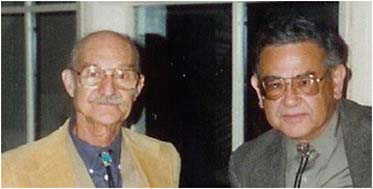
FIGURE 1.9 Robert Herman (left) and Ralph Alpher (right) at the launch of the COBE satellite. They worked out the Big Bang physics under Gamow. SOURCE: Courtesy of NASA.
Bang. The companion paper by Dicke, Peebles, Roll, and Wilkinson gave the interpretation of the Penzias and Wilson discovery. A few months later the Princeton group confirmed the measurement at a different wavelength. Then the race was on to learn all about the cosmic microwave background radiation, or CMB, as it came to be called.
Inflation, and How Did That Little Ball Make the Whole Universe?
There were a lot of mysteries about the Big Bang, and one of them was How could the universe become so completely uniform (as it appears today) if there has not been time for the different parts to communicate with each other? So, scientists were looking for a way to make the whole universe erupt from some primordial material that was pretty uniform. In 1980, Alan Guth found such a theory, now known as Cosmic Inflation. Guth found a way to apply the theory of elementary particles to imagine a new kind of cosmic energy that could take a small volume of space, say 10 centimeters (cm) across, and make it grow exponentially, doubling in size around a hundred times in the tiniest fraction of a second. So if that is what happened, then the 10-cm ball of primordial material could grow big enough to kick off the expanding universe we see today.
Needless to say, the conditions in such a little ball were extreme, but nevertheless, it seems possible to calculate many things about it. This is now the favored picture of the origin of the universe: a 10-cm blob of primordial material, probably surrounded by other stuff that is a bit different, that has a quantum fluctuation and starts to expand exponentially, stretching out space and time and filling them with the stuff of physics: particles, antiparticles, quarks, gluons, leptons, photons, gravitational waves, and so on, and so on.
Then, skipping many details that have been calculated and might even be true, the universe expanded and cooled. When it was a few minutes old, some of the neutrons attached themselves to the protons and made helium nuclei, and traces of lithium. And that is it as far as nuclear reactions went, until the formation of stars.
When the universe was about 380,000 years old, it reached a temperature of about 3,000 K, and that was cool enough that the electrons could stick to the atomic nuclei and make neutral gas. That’s an important day for us, because when that happened, the gas became transparent, and the heat radiation became free to move across the universe. This event is called the Decoupling, because the radiation and the matter were no longer coupled together. Moreover, the radiation was then free to come to us, human observers, almost unchanged. The expansion of the universe stretched out the wavelengths, reducing the temperature of the radiation accordingly, but the brightness pattern we see today was mostly imprinted on the radiation when the universe was 380,000 years old.
Then, the universe entered a kind of “Dark Ages,” when nothing much happened except expansion and cooling. But during this quiet time, gravitation was working, pulling on the denser parts of the universe and reversing their expansion. According to calculations, if the early universe had been completely uniform, we could not ourselves exist, because no part of the universe would have stopped expanding. So this is a very interesting question: How did the material begin to move to make stars and galaxies?
We calculate that the first stars and galaxies could have formed when the universe was a few hundred million years old and maybe 1/10 or 1/20 as large as it is today. The first objects might have been very massive stars, maybe a few hundred times as massive as the Sun, and they would have burned very hot (maybe 100,000 K) for about 3 million years. Then, they would end their lives in supernova explosions, possibly producing black holes, as well as liberating the heavier chemical elements that make up places like Earth. If stars and planets had formed from this enriched material, it is conceivable that life might have formed soon after, in the first hundreds of millions of years after the Big Bang.
Then, somehow, ordinary galaxies of ordinary stars were formed. This process is a great mystery, though numerical calculations are giving us a hint. It seems likely that galaxies evolve by colliding with and absorbing their neighbors, and indeed the Milky Way still has two small satellite galaxies (the Magellanic Clouds) that are still falling in. Then, quite recently on a cosmic scale, only 4.5 billion years ago, the Sun formed with the planets, apparently rather abruptly from the isotopic evidence in various residual bits of the early solar system. So our solar system is very young, only 1/3 of the age of the universe.
Very Recent History
We have evidence that life appeared on Earth shortly after it became cool and wet enough to support life as we now it, but that is a topic for another science. And shortly after a small asteroid made a crater in the Yucatan about 65 million years ago, mammals replaced dinosaurs as the dominant large land animals. Only a million years ago or so, the large mammals of today came into their present forms: lions, elephants, and humans (or their ancestors). And in 1609, Galileo pointed his newly improved telescope at the heavens and discovered satellites of Jupiter, craters and mountains on the Moon, and spots on the Sun. Copernicus was right, the Protestant Reformation was in full swing, and science was politicized. But Galileo was buried in honor in Santa Croce in Florence, Italy, across the hall from Michelangelo, and now the Church has admitted to a terrible misunderstanding. Moreover, the Vatican maintains its own observatory and sponsors conferences on cosmology.
In 1905, Einstein had his Miracle Year of major discoveries; we celebrated the International Year of Physics in 2005; and in 2009, we will celebrate Galileo’s discoveries with the International Year of Astronomy.
Just 50 years ago, on October 4, 1957, the Sputnik launched a new era of the space race. Started as a scientific research project, it had huge effects on the world. NASA was founded a year later, on October 1, 1958.
The Future
Perhaps in another 50 years, we will find signs of life on other planets. But certainly, in a billion years or so, the Sun will be so bright that there will be no place on Earth capable of supporting life. And in about 5 billion years, it is predicted that the great Andromeda Nebula will collide with the Milky Way, changing its shape beyond recognition. Possibly the Sun will end up orbiting around the Andromeda nebula. And then, about 7.6 billion years from now, the Sun will expand so much that Earth will orbit inside its surface. Shortly after, the Sun will go out. Then, over billions of years, the remaining hydrogen and helium gas will form new stars, those stars will themselves burn out, and the universe will become mostly dark. If present trends continue, most of the distant galaxies will continue to recede from us, and the universe will seem small and isolated. But, since we do not know why the universe is expanding now, we do not know if it will continue. Perhaps there will be the Big Crunch, a.k.a. the Gib Gnab.
THE STORY OF COBE, THE COSMIC BACKGROUND EXPLORER
In 1970, I was looking for a thesis project at the University of California, Berkeley, just 5 years after the discovery of the CMB. At the time there had been some really wrong measurements of the CMB at short wavelengths, around a millimeter, so it was a time to try a thesis project. Mine involved a ground-based measurement at White Mountain with Mike Werner and Paul Richards, and then a balloon payload with David Woody and Paul Richards and Norm Nishioka. It was tough work, and the balloon payload did not work right on the first flight. I left Berkeley thinking I would try something easier as a postdoc in radio astronomy with Pat Thaddeus at the Goddard Institute for Space Studies in New York City. But in 1974, a few months after I arrived in New York, NASA announced an opportunity to propose new scientific satellites, and it seemed obvious that a better version of my thesis work had to be proposed. My advisor, Pat Thaddeus, gave me some names, we called them up and made a team, and we submitted our proposal. In 1976, NASA chose to make a new team, composed of members of our team and two other teams, to define the new mission. So I moved to Goddard Space Flight Center in Greenbelt, Maryland, to work on it. The new team named it the Cosmic Background Explorer, or COBE.
The hair-raising details of this project are well told in the book The Very First Light, a popular account by
John Mather and John Boslough. The project suffered many perils, and had to be re-designed after the loss of the space shuttle Challenger. But it was finally launched on November 18, 1989, and almost immediately began returning data.
Proving the Big Bang
You cannot prove the Big Bang. But you can test the predictions of the theory, and you can compare them with other theories. There were two major predictions: First, the spectrum of the CMB should match that of a perfect black radiator at a temperature of about 2.7 K. Second, the CMB should be slightly non-uniform (anisotropic, in Greek), so that some parts of the universe would have enough gravitation to stop expanding and turn into galaxies, stars, and people.
The first experiment to report scientific results was the FIRAS, the Far Infrared Absolute Spectrophotometer. This was my thesis project, grown larger and made to work very well by professional engineers. When I presented the first results to the American Astronomical Society in January of 1990, I showed them a graph that had the measurements as little boxes and the theoretical curve as a solid line (Figure 1.11). All the boxes were right on the line. The result was a standing ovation from the audience of about 2,000 astronomers. I was completely unprepared for this response, since I had always thought I knew the right answer: the CMB must have the predicted form. But the audience knew that there had been repeated measurements that showed that the spectrum did not match the blackbody predictions. And there were many papers showing that it required very implausible theories to explain these deviations. So it was a huge relief for the crowd that (a) the Big Bang was now safe, and (b) none of these exotic theories were required.
Prior to the discovery of the CMB, the dominant alternate theory about the universe was the Steady State theory, which held that the universe has existed for an infinite amount of time and that, although it seems to be expanding, it is continually being refilled by the creation of new matter. This theory does allow for the existence of a cosmic background radiation, produced by stars through the infinite history of the universe, but it does not predict that the spectrum should match the perfect black radiator. So, in 1965 the Steady State theory was already dying because of the discovery of the
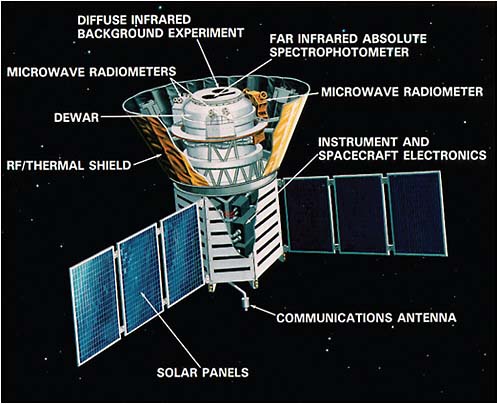
FIGURE 1.10 The COBE satellite in orbit 900 km above Earth. The instrument package is protected by conical shield. The Sun is to the side, and Earth below. SOURCE: Courtesy of NASA.
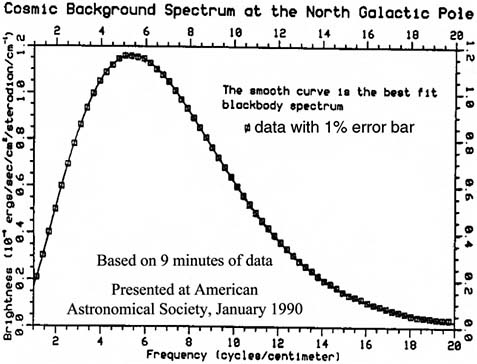
FIGURE 1.11 First public spectrum of the CMB from the COBE FIRAS instrument, shown at AAS meeting in January 1990, received a standing ovation. SOURCE: Courtesy of NASA and the COBE Science Working Group.
CMB, and in 1990 it became very difficult to make the Steady State match the CMB spectrum.
In the end, we reduced the error bars to about 50 parts per million. The CMB has a spectrum that is as close to the theoretical prediction as we can measure.
Why Are We Here? The Pink and Blue Blobs
The second major result from the COBE was announced in April 1992. The Differential Microwave Radiometer (DMR) instrument was designed to map the brightness of the CMB and to look for tiny differences in brightness from one place to another. Considering that the differences we found are very, very faint, only 30 micro-K, and that the instrument operates at a temperature of 140 K or 300 K depending on the channel, this is an extraordinary accomplishment, pulling tiny signals out of mountains of noise. It depended on making hundreds of millions of measurements and fitting them to a map of the sky using a “least squares fit” on a computer.
We found the map in three scientific stages (see Figure 1.12). First, we made the map of the sky, represented as an oval, with the center of the galaxy in the middle. This map shows a small difference between one part of the sky and the other: half of the sky is pink, and half is blue. This is the expected result if Earth is moving relative to the rest of the universe, with a speed of about 300 km/s toward the constellation of Leo. It’s
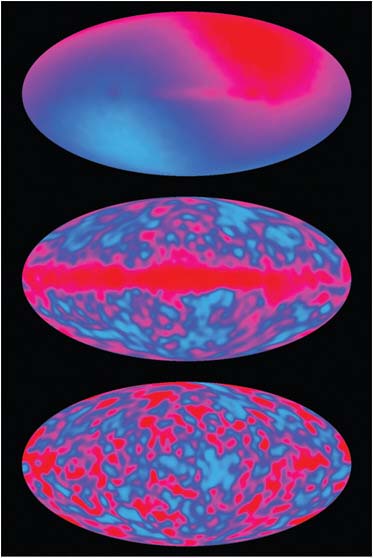
FIGURE 1.12 The first published all-sky maps of the CMB fluctuations. SOURCE: Courtesy of NASA and the COBE Science Working Group.
not of cosmic significance, but eventually we’d like to know why we have that speed. Second, we subtracted off that effect, and we got a map that has a lot of pink and blue blobs and a strong reddish band across the middle. That’s the Milky Way galaxy, emitting microwave radiation because there are electrons spiraling around magnetic fields and bumping into protons. We were expecting that effect too, and we mapped the sky at three different wavelengths so we could tell what part of the map came from the electrons and what part came from the Big Bang. So the third map is all pink and blue blobs, and except for measurement errors, they all come from the Big Bang.
When Steven Hawking saw these maps, he said it was the discovery of the century, if not of all time. At first I thought he was being too generous, but now I would like to point out that if it were not for these blobs, we could not exist. These blobs map out the density differences in the early universe, and as it happens the cool (blue) blobs come from dense regions. And if there were no spots that were dense enough to stop the expansion, we would not be here to measure them.
The Nobel Prize
On October 3, 2006, I was awakened by a phone call from Sweden, wanting to know if I were the real John Mather who worked on the COBE satellite. People had been telling us for years that we had done Nobel-worthy work, and now it was happening! The next months were a whirlwind of preparations for 10 days of parties and speeches in Stockholm. The big challenge was to arrange for as many as possible of the COBE team members to go to the big event. George Smoot, my co-winner, and I each had a quota of 16 invitations. I would like to specifically mention that Ned Wright, the data team leader on COBE, was the first to compute the maps of the pink and blue blobs, and that Chuck Bennett, deputy principal investigator for the DMR instrument, was crucial for the success of the measurement. Bennett is also the principal investigator for the WMAP, the Wilkinson Microwave Anisotropy Probe, which made a tremendous improvement on the DMR measurements, and showed as well that the DMR maps were correct. Without that confirmation, perhaps the Nobel Prize would not have been given to us.
What’s Next with the CMB?
The CMB has been astonishingly informative, considering how difficult it was to measure it. The DMR map had 6,144 pixels, and there may already be more than 6,000 scientific papers citing the DMR work. The WMAP already made far more detailed maps, with far sharper images and far better sensitivity. Its maps have revealed some huge surprises and confirmed others. First, the universe is filled with dark matter and dark energy—that are both far more abundant than ordinary matter. According to WMAP and other measures, the universe is composed of about 4 percent ordinary matter, 23 percent dark matter, and 73 percent dark energy. The dark matter has been suspected for a long time, going back to Fritz Zwicky in 1933, but now it is clear: the pattern of speckles on the microwave map can not be explained by ordinary matter. Dark matter is not coupled to the radiation field and is free to move under the influence of gravity, long before the decoupling event at 380,000 years, so the pattern has a different shape than it would have with ordinary matter alone.
As it happens, it was also discovered (in 1998) that distant supernovas are too faint, quite a lot too faint—about 20 percent or so—way too much to be explained by experimental error. The interpretation was that the universe is larger than it seems from the velocity of expansion, and that would be so if the universe has been accelerating. This was pretty shocking when it was discovered by the High Z team and later confirmed by the Supernova Cosmology Project, but their discovery has stood the test of time. In particular, the acceleration changes the pattern of speckles on the WMAP image of the sky in just the way that would be expected if the acceleration determined from the supernovas is really there. The big questions now for astronomy are What is that dark matter doing? How does it relate to ordinary matter? and What is causing the acceleration? We call that acceleration force “dark energy” to be able to talk about something, but in truth it was not expected by many theorists, and we see no obvious reason why it should exist.
The CMB also may harbor traces of something even more exotic: gravitational waves in the primordial material. If these waves existed, with the amplitude predicted by many theories of inflation, then they would produce an imprint of a certain pattern of po-
larization of the CMB. The hunt for this polarization has already started, with some preliminary results, but the final answer may require an even more sensitive satellite mission.
“MY” NEW PROJECT: THE JAMES WEBB SPACE TELESCOPE
In 1995, the COBE mission was done, and I was writing a book about it with John Boslough. The HST was up and working beautifully after its repair, but it had been very difficult and costly. I thought NASA might never again do something as exciting and challenging as the COBE or the HST, but one day in October, I received a phone call from Ed Weiler, the new head of the Origins Theme at NASA Headquarters and the long-term guiding light for the HST. Weiler knew that we needed to plan for the successor project after the HST and had already started a committee going to define what it ought to do. The committee, chaired by Alan Dressler, wrote a beautiful report called HST and Beyond, which outlined two objectives. First, NASA should build a new space telescope that is optimized for near infrared wavelengths (1 to 5 micrometers) as large as possible, at least 4 meters in aperture. Second, NASA should start planning for missions to observe Earth-like planets around other stars. In 1995, Michel Mayor and Didier Queloz announced that the nearby star 51 Pegasi has a big planet orbiting close in; not exactly Earth-like, but tantalizing. Obviously, NASA (and other space agencies) would have to follow up on this discovery. Now, we know of over 300 exoplanets of many different types, mostly found by this radial velocity technique.
So Ed sent a little money to Goddard Space Flight Center and we got started on a study, working with the Space Telescope Science Institute in Baltimore, with industrial partners, and gradually with international partners, the European and Canadian space agencies. Under the leadership of Dan Goldin, NASA was trying to reach out far beyond the realm of the currently possible, and an extremely ambitious telescope was just the thing. The initial studies said that a telescope 8 meters across could be built at an affordable price, even though it would have to fold up like an origami bird to fit into the rocket. New technologies were needed, but the plan was to develop them all to a high level before they were really needed. By 2007, we had a list of 10 new technologies that would be needed, and all of them were ready, which means that representative designs had been tested in the relevant space-like environment.
The JWST Team
The JWST project is led by project manager Phil Sabelhaus at NASA Goddard Space Flight Center and includes major contributions from other parts of NASA at Marshall Space Flight Center, the Jet Propulsion Laboratory, and Johnson Space Center. The observatory will be operated by the Space Telescope Science Institute in Baltimore, Maryland.
NASA held many competitions to choose the team members for the telescope. In the end, the prime contract was awarded to TRW. The part of TRW doing the telescope was then bought by Northrop Grumman and became Northrop Grumman Space Technologies, located near Los Angeles Airport. Their major subcontractors include Ball Aerospace, ITT (formerly Kodak), and ATK.
The JWST Concept
This new telescope does not look much like any telescope you’ve ever seen (Figure 1.13). First, it has to fold up, and second, it has to get cold. So it will fly to deep space, a million miles from Earth, and orbit around the Sun–Earth Lagrange point L2 (Figure 1.14). It will have a folding sunshield, with five plastic layers to achieve a Sun Protection Factor of a million, to let the telescope cool itself down to 40 K. It will not have a protective tube: if it did, it would not be able to radiate away its heat to outer space. So it ends up looking more like a solar energy concentrator than like the HST. But it will be far more powerful, with a mirror collecting area more than 6 times that of the HST, with infrared instruments that the HST can not use because it is too warm, and with advanced camera chips far beyond anything known before.
Naming the Telescope
Originally called the Next Generation Space Telescope (a lot of our colleagues were Star Trek fans), the new machine was finally named after the second
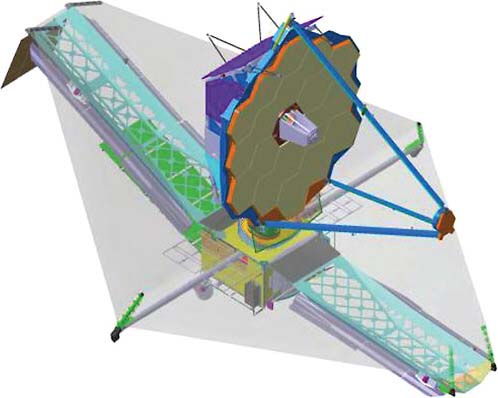
FIGURE 1.13 James Webb Space Telescope, planned for launch in 2013 as successor for the Hubble Space Telescope. SOURCE: Courtesy of NASA Goddard Space Flight Center.
administrator of NASA. Scientists rebelled: Should not every observatory be named for a great scientist? But James E. Webb, the man who built NASA to go to the Moon, did more for science than most people know. He personally persuaded John Kennedy that the science done with the Apollo program would outlast the political statement and have lasting value for the USA. As a result, Webb initiated the creation of space science laboratories at universities around the country. Science owes a lot to James Webb. For more details, consult the fine biography Powering Apollo by Henry Lambright.
Folding Mirror!
The most obviously difficult part was the giant primary mirror. It would have to be built in segments and deployed after launch. Then it would have to be adjusted to the right shape, using the mathematics that we
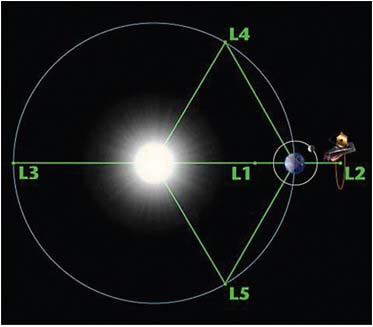
FIGURE 1.14 The 5 Lagrange equilibrium points of the Sun– Earth system, discovered in 1772. JWST orbits the L2 point, a million miles from Earth, and is overhead at midnight. SOURCE: Courtesy of NASA.
learned when we had to fix the HST. It would all have to happen by remote control, long after the last human could touch it. We held competitions for the mirror technology, with about a dozen contracts to famous optics companies. In the end, there was a shoot-out between two leading designs. One used a sandwich of ULE® glass sheets bonded to a glass honeycomb for light weight. The other used pure beryllium metal machined to remove 95 percent of the material and polished very carefully. In the end we chose beryllium, because the glass sandwich did not hold its shape when it was cooled down to the low temperatures we needed, around 40 K. But the beryllium is a tough material to use: it’s very strong, very stiff, very light, and very hard, but it can change its shape a little if a rather modest pressure is applied, and powdered beryllium can be quite toxic.
Now, we are polishing the mirrors for the flight telescope. It takes about 4 years to get from powdered beryllium to polished hexagons, and we’re about half done with the process.
Adjusting the Mirror
After the HST experience, people are a little touchy about telescope mirrors in space, so we have built a testbed telescope, 1/6 scale, to learn everything about adjusting the real one. Our current plan requires 11 different adjustment methods to get from the initial deployment to a nearly-perfect mirror, so all 11 have been tried out on the testbed. It takes a computer a day or so to adjust the testbed, but we expect the real space telescope to take weeks. (Figure 1.15)
Testing the Real Telescope
One of the lessons from the HST was that conservative engineers are right: test as you fly, fly as you test. It was believed that a full test of the HST optics was too expensive. But if you do not have time to do it right, when will you have time to do it over? That’s the title of an inspirational book on time management. So the test plan for the new telescope is very carefully designed to catch every possible kind of error that our engineering teams can imagine and to be ready to catch the unimagined errors as well. The big test will be held at Johnson Space Center in the same vacuum tank used
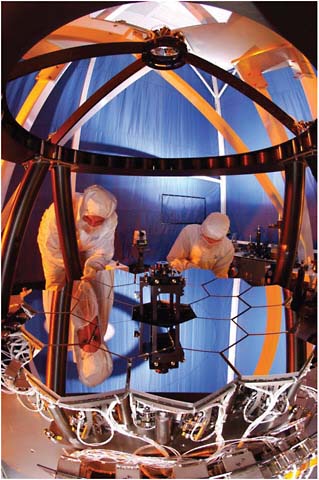
FIGURE 1.15 The JWST mirror rack. SOURCE: Courtesy of Ball Aerospace Corporation.
by the Apollo astronauts to get ready for the Moon (Figure 1.16). It’s so old, it’s on the Historic Register.
In the big tank, the telescope will be at the bottom looking up. At the top will be test equipment located at the center of curvature of the primary mirror, as well as 3 autocollimating flat mirrors that will reflect light back into the telescope. A tiny light at the focal point of the telescope will radiate outwards to the flat mirrors, and their beams will return through the telescope to detectors to create an end-to-end test. The telescope will be cold and in vacuum, but of course not in zero gravity.
Scientific Objectives and Instruments
The JWST will collect light from distant stars and galaxies, and instruments will spread it out into images and spectra for transmission back to the ground. There are four main scientific topics that will certainly be investigated by users of the telescope, along with many others that will be proposed by observers:
-
The end of the Dark Ages: first light and reionization of the universe,
-
The assembly of galaxies,
-
The birth of stars and protoplanetary systems, and
-
Planetary systems and the origin of life.
To enable these investigations, the JWST will carry four instruments:
-
The Near Infrared Camera (NIRCam), being produced by the University of Arizona with its major contract to Lockheed Martin;
-
The Near Infrared Spectrograph (NIRSpec), being produced by the European Space Agency (ESA) with its major contract to Astrium;
-
The Mid Infrared Instrument (MIRI), produced by a European Consortium led by the United Kingdom Advanced Technology Center (UKIRT), in partnership with the Jet Propulsion Laboratory; and
-
The Fine Guidance Sensor (FGS), including the Tunable Filter Imager (TFI), produced by the Canadian Space Agency, with their major contractor COMDEV.
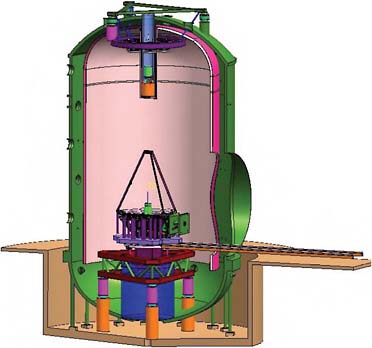
FIGURE 1.16 JWST optical system in test chamber at Johnson Space Center, looking up to test apparatus at top of chamber. The end-to-end test! SOURCE: Courtesy of NASA.
The near infrared instruments (NIRCam, NIRSpec, FGS, and TFI) cover the wavelength range from red (0.6 microns) to 5 microns, and the MIRI covers the range from 5 to 28 microns. The near-infrared detectors are all made with mercury-cadmium-telluride (HgCdTe) sensing layers and are produced by Teledyne (formerly Rockwell), and the mid-infrared detectors are arsenic-doped silicon produced by Raytheon.
The End of the Dark Ages
The prime objective in this area is to discover and measure the earliest possible objects that formed after the Big Bang. As described above, theoretical predictions suggest that these were extremely massive stars, hundreds of times the mass of the Sun, that would be extremely hot and bright, burning out in a few million years with some kind of spectacular supernova explosions. If so, individual supernovas could be detectable from a time when the universe was only a few hundred million years old. To find them, the JWST would survey the sky, returning repeatedly to the same areas to search for objects that have changed in brightness. Close to home, supernovas rise rapidly to maximum brightness in a few days and then slowly decay over a period of months. The most distant ones will show time dilation, with days stretching into months and months stretching into years.
We also imagine that the first objects may have been clustered together because of the way in which the primordial density variations combine to enable gravity to slow and stop the expansion of the original material. If so, we might find proto-galaxies containing thousands of massive stars burning near each other.
We would recognize the first objects in several ways. First, they would be extremely hot, as expected from the lack of heavy chemical elements in them. Second, they would be embedded in the primordial hydrogen, so their ultraviolet radiation at rest wavelengths less than 0.1216 microns would be cut off by absorption by that intergalactic hydrogen. We would use the NIRCam to search for the objects and to determine whether they show the predicted lack of ultraviolet radiation due to the hydrogen. Third, they might be clustered together, with a group all at the same redshift. We would use the TFI to hunt for this effect, since it can be set to search for objects emitting
hydrogen Lyman-alpha spectra at a specific redshift. Fourth, their spectra would show no signs of elements heavier than the primeval hydrogen and helium. Unfortunately, this last step is very difficult, because it requires not only discovering the first objects, but also obtaining their spectra. We would carry out this step with the NIRSpec, which has been optimized for just this purpose. The NIRSpec is capable of observing 100 candidate objects at the same time, using a remarkable new technology of microshutter arrays.
According to predictions, these first objects are outside the range of ground-based telescopes and even the HST, because the expansion of the universe has stretched the original ultraviolet light out into the infrared by the time we see it. So, we need a giant space telescope capable of observing the infrared.
The Assembly of Galaxies
We would very much like to know how our own home galaxy, the Milky Way, was formed. We now have two small satellite galaxies, as do many other galaxies. We imagine that the Milky Way has grown by absorbing many such small galaxies, and we can check this theory by observing other galaxies like ours. With the JWST, we will look back in time to see how different the early galaxies were in shape, rotational characteristics, color, brightness, chemical composition, and temperature. In addition, we would pursue one of the great current mysteries: Why is there a giant black hole in the middle of almost every galaxy? Did the galaxy make the black hole, or did the black hole make the galaxy? Was there just one black hole made per galaxy, or were there many of them, merging together later to make bigger ones?
We currently see that most galaxies are either spiral in shape, like the Milky Way, or elliptical. We already know that at earlier times, many more galaxies were irregular in shape, as though their internal motions had not settled down. We also know that at early times, galaxies collided frequently with one another. It appears that the universe became a much more peaceful place around the time that the Sun was formed about 4.5 billion years ago. Curiously enough, that is also when the expansion started to accelerate.
In any case, this whole story has to be checked by measurement. Thousands of galaxies will be observed; cataloged; classified by shape, redshift, color, spectra, and brightness; and then compared with simulated galaxies based on theories about how this process is supposed to have worked.
The Formation of Stars and Planetary Systems
Understanding the history of the solar system has always been one of the fascinating challenges of astronomy. Early astronomers had no idea that the solar system was very old, and, indeed, before the discovery of nuclear energy and the conversion of mass into energy it seemed the Sun had to be very young. But now, we see stars forming before our very eyes in nurseries like the Orion Nebula (the fuzzy spot in Orion’s sword). Some stars are hot and bright and must be very young, only a few million years old, otherwise they’d already be burned out. But the process is largely hidden from us now, because the nebulae where birth occurs are dusty. The dust itself is a part of the process, because it shields the gas clouds from external heat and enables the gas to cool and condense into massive knots that then become stars. Using visible light, the HST gave us the famous pictures of the Eagle Nebula, also called “the Pillars of Creation,” where bright new stars have just been born (Figure 1.17). Using infrared light, the Very Large Telescope in Chile has shown us that we can see inside the dust clouds. However, most infrared wavelengths do not reach ground-based telescopes, because the atmosphere is opaque, so we need an infrared telescope in space to see better. The JWST MIRI will be especially important for this task because it observes wavelengths that pass through the dust clouds very well and that are emitted by objects far too cool to emit visible light. The MIRI includes both cameras and spectrographs to detect candidate young stars and stellar nurseries and to analyze their temperatures, structures, and compositions.
Planetary Systems and the Origin of Life
Since the first planets around other stars were discovered in 1995, the tantalizing possibility that some might harbor life has driven intense efforts to learn more about them. There are several major topics to investigate.
First, we have small residual pieces from the formation of our own solar system that are orbiting the
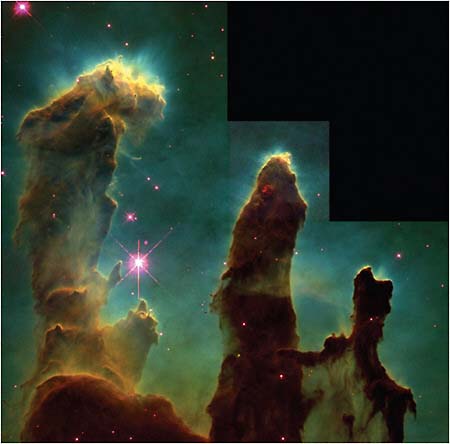
FIGURE 1.17 The Eagle Nebula, the “Pillars of Creation,” where stars have been formed in the last few million years. Dust obscures the birth sites, but JWST can see through the dust. SOURCE: Courtesy of NASA, ESA, STScI, J. Hester and P. Scowen (Arizona State University).
Sun but far from here—in the outer reaches beyond Neptune and in the asteroid belt between Mars and Jupiter. Understanding how these pieces relate to our own existence is a great challenge for solar system exploration, either by robot, in person, or by remote observation with telescopes. JWST will use all its instruments to find and study the small bits, along with the well-known planets.
Second, we know of dozens of transiting planets—objects that pass between ourselves and their host stars, blocking starlight. The Hubble and Spitzer space telescopes have already been used to determine the orbit, temperature, and even the atmospheric composition of a few exoplanets. NASA plans to launch the Kepler observatory in 20091 to find many more transiting exoplanets, including a predicted handful of Earth-like planets around Sun-like stars. Needless to say, the JWST will be devoted to following up these observations as well as possible.
Third, we know of locations where dust clouds orbit distant stars in a way that suggests the presence of planets. The shapes of the dust clouds sometimes tell us that a planet must exist and sometimes where it ought to be and how big. The star Fomalhaut has a dust ring around it, offset a bit, and a good explanation is that there is a large planet at a particular spot, fairly far
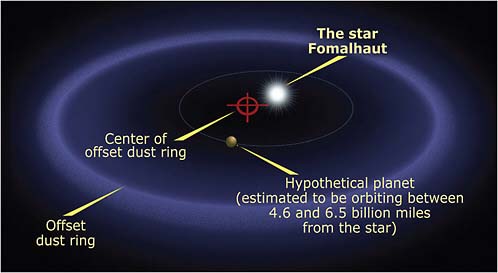
FIGURE 1.18 Drawing of dust ring around Fomalhaut, pulled off center by hypothetical planet that could be observed by JWST. SOURCE: Courtesy of NASA, ESA, and A. Feild (STScI).
from the star. (See Figure 1.18.) Moreover, this system appears to be young, so the planet might be hot enough to measure directly with the JWST. Three of the four JWST instruments will have coronagraphs, devices that block the bright glare of a star to enable us to hunt for faint planets nearby.
After JWST, The Search for Life Elsewhere
The same committee report that recommended the JWST also recommended that telescopes should search for planets around other stars. NASA and ESA have studied three main types of such telescopes. First, an extremely well-made telescope with extremely good coronagraphs could see planets directly. For a long time, I thought that this would be the easiest method, since the telescope is relatively small and could fit into a single rocket payload, like the JWST. However, perfection is difficult to achieve, and this technology is not quite ready yet. The second method would use a group of infrared telescopes flying in formation in space, relaying light beams to a combining station.. This is called an interferometer, which can be used to direct the starlight away from the image of the planet. But this is also difficult and requires formation flying technology with extremely good accuracy, which we do not have yet either. The third technology is a remote blocking device flying in formation tens of thousands of kilometers away from a general-purpose telescope in space. Such a device was proposed for the JWST but was not ready yet. Recent progress on blocking devices (called occulters) has been rapid, and both Northrop Grumman and Lockheed are working with scientific teams to develop this method. The technology is still difficult, but it does not require perfect optics, and the shifts the demands to spacecraft engineering.
What would be signs of life on a planet around another stars? Earth seen at a great distance would be recognizably alive, because of photosynthesis, which has filled our atmosphere with oxygen (Figure 1.19). Oxygen is so reactive that it would quickly disappear if it were not continually regenerated by algae and land plants. So, if we could find signs of oxygen in the atmosphere of an exoplanet, along with other signs like carbon dioxide and water, we could argue we had found another Earth. And on Earth, chlorophyll has a
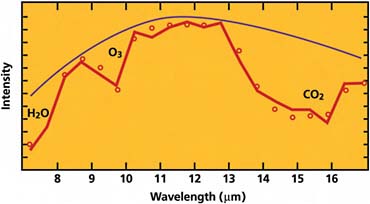
FIGURE 1.19 Spectrum of Earth from a distance, showing features of water, ozone, and carbon dioxide. The combination would not occur on Earth without photosynthetic life. SOURCE: The TPF Science Working Group, The Terrestrial Planet Finder (TPF): A NASA Origins Program to Search for Habitable Planets, JPL Publication 99-003, C.A. Beichman, N.J. Woolf, and C.A. Lindensmith, eds., May 1999. Courtesy of NASA Jet Propulsion Laboratory.
distinctive color. We might also be able to tell if there are continents and oceans, even without making maps of other planets, because the color and brightness of Earth changes as it spins.
And what of life that is based on some different chemical system? Biologists are taking this question seriously and there is even a professional journal about it: Origins of Life and Evolution of Biospheres, a journal of the International Astrobiology Society. So if there are other chemical systems that support life, at least we might think of them and recognize their signs.
Some argue that the function of carbon-based life is to create artificial life, maybe based on silicon electronics that can travel through the universe. If it exists already, either here or elsewhere, we have not noticed yet. But maybe it’s not impossible—have a look at Ray Kurzweil’s book The Singularity is Near.
Big Questions, Open Now
To conclude, let me say that there are many questions that are way too difficult to answer today, but that may become answerable in the near or distant future. These include: What happened before the Big Bang? What’s at the center of a black hole? How did we get here? Are we alone? What is our cosmic destiny? What are space and time?
Perhaps you who are in the audience or reading this later will be the ones to find these answers.
ACKNOWLEDGMENTS
Beginning with elementary school, my work has always been supported by the U.S. taxpayers. Thomas Jefferson and Ben Franklin would be proud that their country has produced scientific and technological knowledge that they could never have imagined. More specifically, my parents Martha and Bob, my wife Jane, my scientific mentors Paul Richards, Mike Hauser, Pat Thaddeus, and Nancy Boggess, my project managers, especially Roger Mattson, Dennis McCarthy, Bernie Seery, and Phil Sabelhaus, and at NASA Headquarters, especially Ed Weiler, have all made enormous changes to my life. Without them, nothing would be the same. And without my co-author John Boslough, you would not have our book The Very First Light to read about this series of fortunate events.



















